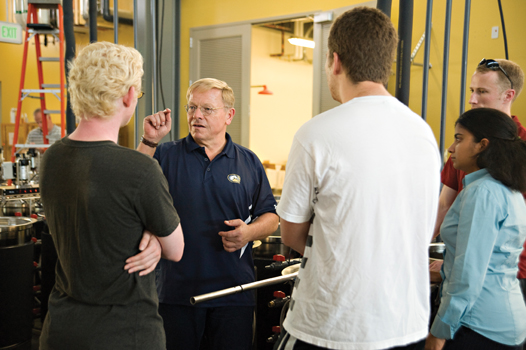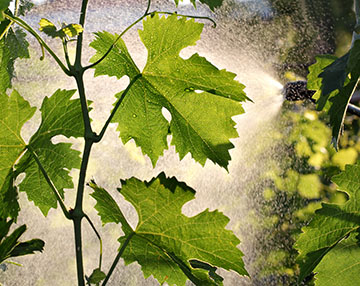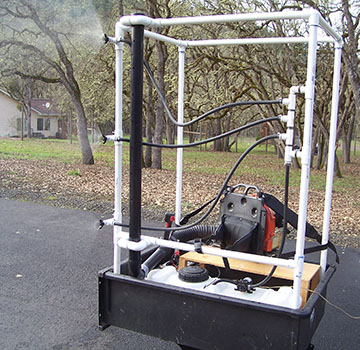
Back in 1995 I took my first viticulture course. I had returned from a short stint as a college instructor in Northern Minnesota, which proved a bit too cold for a third generation Californian. My mother and stepfather had purchased a horse ranch near Lompoc, California in late 1994 with the hopes that the sandy loam soil (slightly fertilized by ten years of grazing) would produce a spectacular crop of Pinot Noir and Chardonnay. But before we could get a crop, we needed to learn how to farm winegrapes.
Steve Pepe, my boss, stepfather and wine mentor, drove me up to Davis, California in 1995 to attend the UC-Davis Extension Program’s three-day intensive viticulture class called “Varietal Winegrape Production.” The course challenged me with an entire new world of jargon, concepts and hard science. It was also frustrating in the sense that they did not offer any easy answers. Every speaker echoed the same sentiment: “Viticulture is so site specific that I can’t offer specific advice that will help all of you.” The week was focused on an attempt to get all the attendees to understand the basics of winegrape growing, which were broken down in the following manner:
1. Cycle of Vine Growth
2. Vineyard Establishment
3. Cultivar Selection
4. Vineyard Management
5. Irrigation Considerations
6. Vine Nutrition/Fertilization
7. Pest Management
Those three days at Davis challenged me. I was taking notes furiously, giving my whole attention to each speaker, trying to absorb the concepts even though I was struggling to understand this new agricultural lexicon that came at me swiftly and without mercy. Words like scion, phloem, vascular cambium and evapotranspiration were never part of my creative writing/liberal arts curriculum in college.
After annotating my handouts and rereading them, I went back to the new ranch in Lompoc (this was just as the vineyard was being planted and while we still employed a vineyard manager) and began to work in the field with the crews. I worked most mornings, five to six days a week, planting, tying, fertilizing, testing and doing field observation. I did this for an entire year, and when I had the opportunity, I went back the next year and took the exact same Varietal Winegrape Production course again. What I found was fascinating.
After developing a “kinesthetic” sense of viticulture, and by that I mean hands-on farming experience, and after having an entire year for the academic aspects of the business to sink into my head, the second course was a revelation. It all made sense, and the concepts that had been so vague and difficult to grasp seemed self-evident and clear. This is a model that I recommend to all budding viticulturists: mix up your education with real-world grape farming. Going back and forth between concept, classroom and the real vineyard is vital in a meaningful viticultural education.
When I came back from that second series of classes, I was fired up and ready to assume my position as the full-time vineyard manager at Clos Pepe. The physical act of living with grapevines for an entire vintage helped drive home the messages and the theory. Sitting in class for another three days was fantastic. The vocabulary made sense, the theory and science was obvious, and the messages that slipped by in the struggle from the previous year sunk in easily and became part of my arsenal for growing good grapes.
So this is the method I’m recommending. Do some reading, take some classes, and then go out there and work in the vineyard with some experts. Prune, tie, clean, sucker, shoot-thin, shoot position, thin fruit, touch up canopy management, learn how to apply irrigation and fertilizer (if needed), take a petiole sample, test fruit, harvest, sort fruit. And then go take some more classes, read some more books, and go do it again. Like anything in life we must balance the theory and the physical work.
How to increase viticultural know-how:
• Volunteer at a neighboring vineyard once a month for an entire year BEFORE you make the decision to plant a vineyard. Most people jump into grape growing blindly and learn as they go. While it may be challenging, it’s not the best way to grow the best fruit. In a perfect world, we would all learn and make mistakes before we pay to plant our backyards. Find a local vineyard that will be a good model for what you want to accomplish in your own backyard. Look for similar climate, soil types and varietals that you are interested in. It’s always a good idea to choose a vineyard that produces wine you find delicious, or at least well-crafted.
• Discover local resources for learning about viticulture and winemaking. These could include local community colleges, state colleges or universities, clubs, groups of enthusiasts, Internet bulletin boards, etc. The most famous of these resources are UC-Davis, Fresno State University and Cornell.
Areas with an established or burgeoning wine industry are likely to have a few classes under the umbrella of the agriculture department, or “agribusiness.” And, of course, there’s no reason why you can’t request (or sign a petition) to get a local school to establish a few classes. If there are few resources local to you, be proactive: find a dozen other interested local growers/winemakers and invite a professor, grower, winemaker or other expert to come and give a lecture. Pay for their travel expense and host a few meals, and you may be surprised just how affordable a private lecture can be. (Or you can invite me, although I don’t come as cheap as a few years ago!) Attend as many classes and lectures as possible, and remember that you can always travel to a distant university once or twice a year if you have to.
• Look into UC-Davis’ Viticulture and Enology courses for Online Learners. Plug this shortened URL into your Web browser: (http://bit.ly/c2g0vR). You will be taken to the home page of the University of California Davis’ Enology and Viticulture Winemaking for Online Learners certificate program. You can enroll as a UC-Davis student right from your computer, and those folks that have tried this program (and discussed it with me), have been very pleased with the experience. You can take courses, exams and even get a certificate from one of the most important winemaking universities in the world.
• Consider taking classes for a Sommelier exam, even if it’s just the lower levels. Without a trained palate, you may not be able to discern what is working and what is failing in your vineyard plan. I meet lots of home winegrowers and home winemakers who admit that their palates are not what I would consider “classically trained.” Without a firm foundation of wine tasting skills, how can you tell if your wines have specific faults? Now, I will be the first to admit that if your wine is delicious in your mouth and in a style that you readily appreciate, there is no reason to change anything. But if there are mystery flaws to your wines, or you are wondering if you could elevate the wines to the next level of quality, then training yourself in wine tasting may be a worthwhile endeavor. The starting (and end) point for all sommelier training is the Wine and Spirit Education Trust in the United Kingdom — the WSET. Check out www.wsetglobal.com and you may be surprised how close the nearest WSET courses are to your home.
There is another very important benefit to this training. You will likely become friends and study partners with the movers and shakers in the local wine scene; folks from the best restaurants, the best wineries, etc. will be your constant companions in your quest for wine knowledge. You will need to constantly taste wines from all over the world, and sharing the cost and purveying will certainly be necessary.
• Use the Internet, but realize almost none of the information presented is peer reviewed. Be picky about what you choose to spend your time with. University and college websites tend to be more accurate than sites compiled by well-meaning, but often misled, individuals. If you can find information that footnotes (or at least mentions) university studies, journals, or other reliable sources, that’s a good start. Also remember that viticulture is painfully site-specific, so a website on how to grow Riesling in the Finger Lakes won’t help much if you’re growing Chardonnay in West Texas.
• Plan your vacations in regions with great vineyards and wine. Let’s assume for the moment that vineyards and winemaking are more important to you than your spouse or significant other. Let’s also assume for a moment that he or she believes, wrongly of course, that you spend too much time and/or money in your winemaking/winegrowing hobby. So when you announce that the yearly vacation is going to be in Napa Valley, suspicions will naturally be aroused. That’s why you have to be trickier . . . er, I mean, more inclusive. (A good example of inclusiveness is how I’ve been gender-neutral throughout this paragraph.) May I suggest a region that is less known for wine and well-known for more traditional vacation activities. If you have to go to Napa, start in San Francisco, and as your better half is at Ghiradelli on a chocolate tour, you jump a bus for a day trip to Napa/Sonoma. Or even better, try Santa Barbara or Solvang. He or she can shop for Christmas ornaments or play golf while you’re touring the Santa Rita Hills or Happy Canyon. In fact, why not plan on coming to Santa Barbara in May, 2011 for the WineMaker Magazine Conference! The same works for many wine regions: Portland, Oregon is very close to both Willamette Valley and the Columbia River Gorge. San Diego is adjacent to Temecula. Be smart: package a vacation correctly and you could be tasting wine and learning about viticulture in places like Florence, Greece and France.
Conclusion: Wine education is some of the most exciting and entertaining types of learning. Plus, there’s little about wine education that’s not in some way romantic: walking vineyard rows, picking fruit, the smell of fermentation, tasting 32 Rieslings in an Alsatian cellar. Another huge benefit is that those who love wine also usually love sharing their passion. Some of the best winemakers and growers in the world are also amazingly hospitable human beings, which is not always true in other professions. We know that the more you engage in the craft of winemaking and winegrowing, the more you will also support wineries and vineyards from all over the world.
The Five Most Important Wine and Viticulture Books in My Library:
• Bryce Rankine, Making Good Wine. Dogeared and abused — I couldn’t make wine without this book. Very technical and precise.
• Jancis Robinson’s Guide to Wine Grapes. What regions grow Cabernet Franc? Where did Petite Sirah originate? This book is where to find out.
• David Jackson and Danny Schuster, Production of Grapes and Wine in Cool Climates. This book is a brilliant appraisal of the wisdom and scholarship needed to successfully navigate the challenges of cool-climate viticulture and winemaking.
• Richard Smart (ed), Sunlight Into Wine. This short tome represents the movement of viticulture into the post-modern era. Revolutionizing our views of canopy management and the term “balance” in viticulture, Smart and his contributors changed the way that grapes are grown from Brisbane to Bordeaux and everywhere in between.
• University of California: Grape Pest Management. If you grow fruit in the Golden State you are 100% obligated to own this thick book . . . outside of California you should still keep it on hand to know the basic and not-so-basic looks of major grapevine diseases, bugs, viruses, etc.







